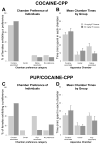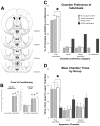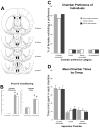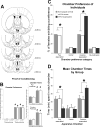The medial preoptic area is necessary for motivated choice of pup- over cocaine-associated environments by early postpartum rats
- PMID: 20156528
- PMCID: PMC2850262
- DOI: 10.1016/j.neuroscience.2010.02.015
The medial preoptic area is necessary for motivated choice of pup- over cocaine-associated environments by early postpartum rats
Abstract
Converging evidence suggests that the motivation to seek cocaine during the postpartum period is significantly impacted by the competing incentives of offspring, a stimulus unique to this life stage. In the present study, the functional role of the medial preoptic area (mPOA), a critical site involved in maternal responsiveness, on processing incentive value of pup-associated cues and influencing response allocation for pup- over cocaine-associated environments was investigated using a concurrent pup/cocaine choice conditioned place preference (CPP) paradigm. Early postpartum females with bilateral guide cannulae aimed into the mPOA or into anatomical control sites were conditioned, from postpartum days (PPD) 4 to 7, to associate different uniquely featured environments with pups or cocaine. CPP was tested on PPD8 following intra-mPOA infusions of either 2% bupivacaine or saline vehicle. In two additional experiments, the effects of intra-mPOA infusions of bupivacaine on expression of conditioned responding induced by environments associated with either pups or cocaine were examined separately. Transient inactivation of the mPOA selectively blocked the conditioned preferences for pup-associated environments, significantly contrasting the robust pup-CPP found in non-surgical and intra-mPOA vehicle-treated females. In contrast, mPOA inactivation failed to alter cocaine-CPP in postpartum females. When given a choice between environments associated with pups or cocaine, transient functional inactivation of the mPOA altered choice behavior, biasing the preference of females toward cocaine-associated environments, such that almost all preferred cocaine- and none the pup-associated option. The anatomical specificity was revealed when inactivation of adjacent regions to the mPOA did not affect CPP responses for pups. The findings support a critical role for the mPOA in mediating pup-seeking behavior, and further suggest that the competing properties of pups over alternative incentives, including drugs of abuse, rely on mPOA integrity to provide relevant pup-related information to the circuitry underlying the choice behavior between pups and alternative stimuli.
(c) 2010 IBRO. Published by Elsevier Ltd. All rights reserved.
Figures




Similar articles
-
Transient inactivation of the ventral tegmental area selectively disrupts the expression of conditioned place preference for pup- but not cocaine-paired contexts.Behav Neurosci. 2009 Dec;123(6):1325-38. doi: 10.1037/a0017666. Behav Neurosci. 2009. PMID: 20001116 Free PMC article.
-
Increasing the incentive salience of cocaine challenges preference for pup- over cocaine-associated stimuli during early postpartum: place preference and locomotor analyses in the lactating female rat.Psychopharmacology (Berl). 2007 Oct;194(3):309-19. doi: 10.1007/s00213-007-0841-9. Epub 2007 Jun 23. Psychopharmacology (Berl). 2007. PMID: 17589831 Free PMC article.
-
Preferences for cocaine- or pup-associated chambers differentiates otherwise behaviorally identical postpartum maternal rats.Psychopharmacology (Berl). 2003 Apr;167(1):1-8. doi: 10.1007/s00213-002-1351-4. Epub 2003 Feb 27. Psychopharmacology (Berl). 2003. PMID: 12607073 Free PMC article.
-
Functional mapping of the neural circuitry of rat maternal motivation: effects of site-specific transient neural inactivation.J Neuroendocrinol. 2011 Nov;23(11):1020-35. doi: 10.1111/j.1365-2826.2011.02200.x. J Neuroendocrinol. 2011. PMID: 21815954 Free PMC article. Review.
-
Preoptic inputs and mechanisms that regulate maternal responsiveness.J Neuroendocrinol. 2014 Oct;26(10):627-40. doi: 10.1111/jne.12185. J Neuroendocrinol. 2014. PMID: 25059569 Review.
Cited by
-
Infralimbic Cortex Biases Preference Decision Making for Offspring over Competing Cocaine-Associated Stimuli in New Mother Rats.eNeuro. 2020 Jul 13;7(4):ENEURO.0460-19.2020. doi: 10.1523/ENEURO.0460-19.2020. Print 2020 Jul/Aug. eNeuro. 2020. PMID: 32631896 Free PMC article.
-
What can challenging reproductive contexts tell us about the rat's maternal behavior?Front Behav Neurosci. 2023 Jul 14;17:1239681. doi: 10.3389/fnbeh.2023.1239681. eCollection 2023. Front Behav Neurosci. 2023. PMID: 37521725 Free PMC article.
-
The Protective Effect of Social Reward on Opioid and Psychostimulant Reward and Relapse: Behavior, Pharmacology, and Brain Regions.J Neurosci. 2022 Dec 14;42(50):9298-9314. doi: 10.1523/JNEUROSCI.0931-22.2022. J Neurosci. 2022. PMID: 36517252 Free PMC article. Review.
-
Early postpartum pup preference is altered by gestational cocaine treatment: associations with infant cues and oxytocin expression in the MPOA.Behav Brain Res. 2015 Feb 1;278:176-85. doi: 10.1016/j.bbr.2014.09.045. Epub 2014 Oct 6. Behav Brain Res. 2015. PMID: 25300467 Free PMC article.
-
The role of ΔfosB in the medial preoptic area: Differential effects of mating and cocaine history.Behav Neurosci. 2016 Oct;130(5):469-78. doi: 10.1037/bne0000160. Behav Neurosci. 2016. PMID: 27657309 Free PMC article.
References
-
- Adams CD. Variations in the sensitivity of instrumental responding to reinforcer devaluation. Q J Exp Psychol B. 1982;34:77–98.
-
- Ågmo A, Gómez M. Sexual reinforcement is blocked by infusion of naloxone into the medial preoptic area. Behav Neurosci. 1993;107(5):812–818. - PubMed
-
- Ashley OS, Marsden ME, Brady TM. Effectiveness of substance abuse treatment programming for women: a review. Am J Drug Alcohol Abuse. 2003;29(1):19–53. - PubMed
-
- Ball SA, Maves LC, DeTeso JA, Schottenfeld RS. Maternal attentiveness of cocaine abusers during child-based assessments. Am J Addict. 1997;6(2):135–143. - PubMed
-
- Band LC, Hull EM. Morphine and dynorphin(1-13) microinjected into the medial preoptic area and nucleus accumbens: effects on sexual behavior in male rats. Brain Res. 1990;524(1):77–84. - PubMed
Publication types
MeSH terms
Substances
Grants and funding
LinkOut - more resources
Full Text Sources

